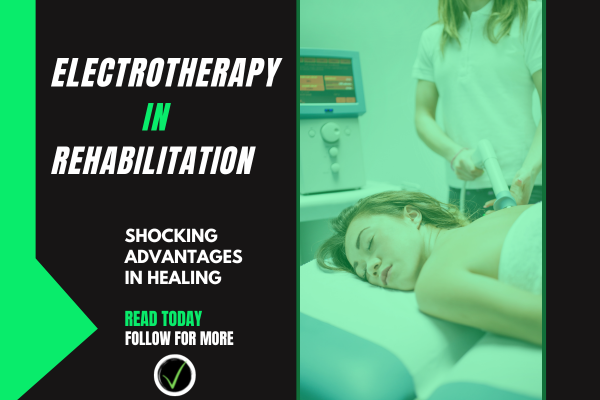Electrotherapy in Rehabilitation: Shocking Advances in Healing

Recovery from injuries and rehabilitation of physical ailments have seen remarkable advancements in recent years.
One of the most innovative techniques gaining recognition in the field is Electrotherapy.
This cutting-edge approach utilizes electrical currents to stimulate muscles and nerves, enhancing the body's natural healing processes.
In this comprehensive article, we will delve into the world of Electrotherapy in Rehabilitation, exploring its mechanisms, advantages, and how it can be seamlessly integrated into rehabilitation programs.
What Is Electrotherapy?
Electrotherapy is a therapeutic method that involves the application of controlled electrical currents to the body.
These electrical impulses are carefully calibrated to target specific muscles or nerves, inducing various physiological responses.
The primary objective of Electrotherapy is to accelerate the healing process, reduce pain, and improve muscle function.
The Benefits of Electrotherapy in Rehabilitation
- Pain Management: Electrotherapy can effectively reduce pain by blocking pain signals and promoting the release of endorphins, the body's natural painkillers.
- Muscle Rehabilitation: It helps in muscle re-education and rehabilitation by stimulating weakened or atrophied muscles.
- Improved Circulation: Electrotherapy aids in enhancing blood circulation, which is crucial for tissue healing and recovery.
- Reduced Swelling: By promoting lymphatic drainage, Electrotherapy can reduce swelling and inflammation.
- Enhanced Nerve Function: It can help in improving nerve function, particularly in cases of nerve injuries or neuropathies.
Types of Electrotherapy Modalities
There are several Electrotherapy modalities commonly used in rehabilitation:
- Transcutaneous Electrical Nerve Stimulation (TENS): TENS units deliver low-frequency electrical currents to relieve pain and discomfort.
- Electrical Muscle Stimulation (EMS): EMS devices stimulate muscle contractions and are used for muscle rehabilitation.
- Interferential Current (IFC): IFC therapy utilizes two high-frequency currents that intersect, creating a modulating current for pain relief and muscle stimulation.
- Functional Electrical Stimulation (FES): FES is used to restore functional movements in patients with neurological conditions.
Incorporating Electrotherapy into Rehabilitation Programs
Integrating Electrotherapy into rehabilitation programs involves a systematic approach:
- Assessment: A thorough evaluation of the patient's condition is essential to determine the appropriate Electrotherapy modality and parameters.
- Customization: Tailor the Electrotherapy sessions to meet the patient's specific rehabilitation goals.
- Supervision: Ensure that Electrotherapy sessions are conducted under the guidance of a qualified healthcare professional.
- Progress Tracking: Monitor the patient's progress and adjust the Electrotherapy parameters as needed.
Safety Considerations
While Electrotherapy is generally safe, precautions should be taken:
- Professional Oversight: Only trained healthcare professionals should administer Electrotherapy.
- Patient Screening: Conduct a comprehensive assessment to identify any contraindications or potential risks.
- Proper Electrode Placement: Ensure correct electrode placement to target the intended muscles or nerves accurately.
Electrotherapy vs. Traditional Rehabilitation
Comparing Electrotherapy with traditional rehabilitation methods reveals key differences:
Electrotherapy
- Utilizes electrical currents.
- Targeted muscle and nerve stimulation.
- Effective pain management.
- Accelerated muscle rehabilitation.
Traditional Rehabilitation
- Manual therapies and exercises.
- Focuses on movement and strength training.
- May require longer recovery times.
- Less targeted pain management.
Electrotherapy for Various Rehabilitation Goals
- Orthopedic Injuries: Electrotherapy aids in the recovery of fractures, sprains, and joint injuries by reducing pain and promoting muscle strength.
- Neurological Conditions: It is effective in rehabilitating patients with neurological conditions like stroke, multiple sclerosis, or spinal cord injuries.
- Sports Injuries: Athletes benefit from Electrotherapy to expedite recovery from sports-related injuries.
- Chronic Pain: For individuals with chronic pain conditions, Electrotherapy can provide long-term relief and improve quality of life.
Sample Electrotherapy Rehabilitation Exercises
- TENS for Lower Back Pain: TENS units can be used to alleviate chronic lower back pain.
- EMS for Post-ACL Surgery: Electrical Muscle Stimulation can assist in strengthening muscles after ACL surgery.
- FES for Stroke Rehabilitation: Functional Electrical Stimulation can help stroke patients regain motor function.
Nutrition and Recovery Strategies
A balanced diet rich in nutrients, proper hydration, and adequate rest are crucial for effective rehabilitation with Electrotherapy.
Monitoring and Tracking Progress
Documenting the patient's progress, including pain levels, muscle strength, and range of motion, is vital to tailor Electrotherapy sessions effectively.
Common Myths About Electrotherapy
Myth: Electrotherapy is painful.
- Reality: Electrotherapy is generally painless, and patients often experience a tingling sensation.
Myth: It's only for athletes.
- Reality: Electrotherapy is beneficial for a wide range of individuals with varying rehabilitation needs.
Success Stories
- Emily: Recovered from a debilitating shoulder injury and returned to competitive swimming with the help of Electrotherapy.
- David: Regained mobility and independence after a severe stroke thanks to dedicated Electrotherapy sessions.
The Future of Electrotherapy in Rehabilitation
As technology continues to advance, Electrotherapy is expected to become more personalized and accessible.
Wearable devices and home-based Electrotherapy options are likely to become more common, allowing patients to take an active role in their rehabilitation.
Conclusion
Electrotherapy in Rehabilitation represents a groundbreaking approach to healing and recovery.
By harnessing the power of electrical currents, individuals can expedite their rehabilitation, manage pain effectively, and regain their quality of life.
While Electrotherapy holds immense promise, it's crucial to collaborate with healthcare professionals to ensure safe and tailored treatment plans.
FAQs
Is Electrotherapy suitable for all ages?
- Electrotherapy can be adapted for individuals of various ages, but it's essential to consult a healthcare professional for suitability.
Are there any side effects of Electrotherapy?
- Side effects are minimal and usually temporary, such as skin irritation at electrode sites. Proper supervision helps minimize risks.
How soon can I expect results from Electrotherapy?
- Results vary depending on the individual and the condition being treated, but many patients experience improvements within a few weeks of consistent sessions.
